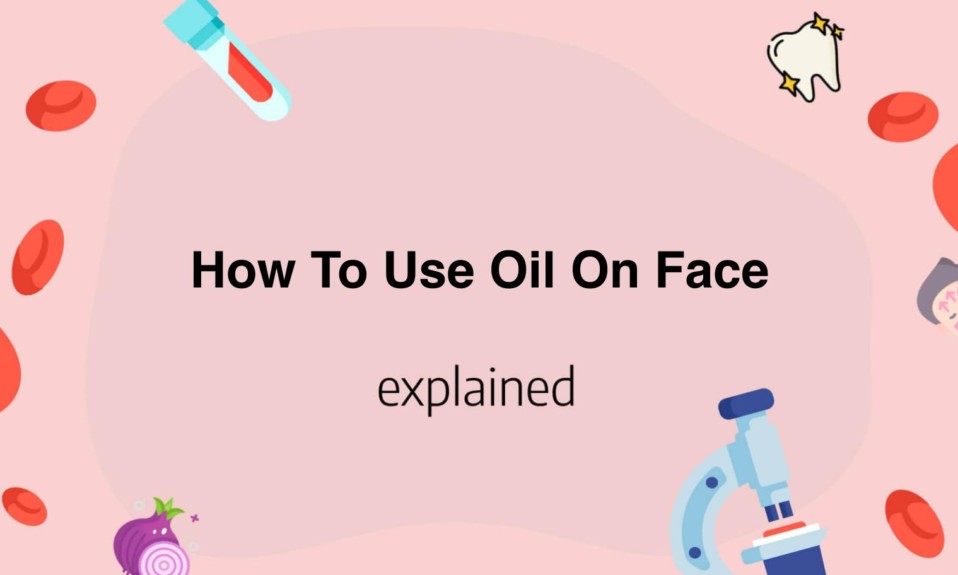Using oil on face has become a popular skincare trend in recent years.
It may seem counterintuitive, but certain natural oils can actually help balance the skin’s oil production and leave it looking radiant.
However, not all oils are created equal and it’s important to choose the right one for your specific skin type.
In this guide, we’ll explore the benefits of using oil on your face and how to incorporate it into your daily routine for a healthy, glowing complexion.
- Start by selecting the right type of oil for your skin type and concerns.
- Apply a few drops of the oil onto your fingertips and gently massage it onto your face in circular motions.
- Leave the oil on for a few minutes to let it absorb into the skin.
- Follow up with a moisturizer to seal in the oil and prevent any water loss.
- Consider using oils as a part of your nighttime skincare routine for maximum benefits.
Benefits of using oil on face
Using oil on your face can have many benefits for your skin.
First, it can moisturize and nourish dry, flaky skin.
Oils such as coconut, almond, and argan oil can penetrate deep into your skin and provide long-lasting hydration.
Second, oils can help balance your skin’s natural oils.
If you have oily skin, using an oil-based cleanser or oil on your face might seem counterintuitive, but it actually can help regulate your skin’s sebum production.
Third, oils can protect your skin from environmental stressors such as pollution, UV rays, and harsh weather conditions.
Some oils, such as grapeseed oil and raspberry seed oil, have natural antioxidant and anti-inflammatory properties that can help shield your skin from free radicals and other damage.
Fourth, applying oils to your face can soothe inflammation and reduce redness and irritation.
Oils like chamomile and tea tree oil have anti-inflammatory properties that can help calm your skin and alleviate conditions such as acne, eczema, and rosacea.
Finally, using a face oil can improve the appearance of your skin, leaving it looking radiant and healthy.
Many oils contain essential fatty acids and vitamins that can help improve skin texture, reduce the look of fine lines and wrinkles, and even out skin tone.
In conclusion, incorporating face oils into your skincare routine can have numerous benefits for your skin’s health and appearance.
Just make sure to choose an oil that is appropriate for your skin type and needs, and always do a patch test before applying it to your face.
How To Use Oil On Face
Using oil on your face can have both benefits and drawbacks, depending on the type of oil you use and how you apply it.
The first step is choosing the right oil for your skin type.
For oily or acne-prone skin, lighter oils such as jojoba, grapeseed, or tea tree may be more suitable, while drier and mature skin may benefit from heavier oils like avocado, argan, or rosehip seed that contain more antioxidants and vitamins.
Once you have found the right oil for your skin, use it sparingly, starting with just a few drops and slowly increasing the amount if needed.
Before applying the oil, make sure your face is clean and dry.
You can either apply it directly to your skin with your fingertips or use a cotton ball to gently dab it on.
Be careful not to massage the oil too vigorously into your skin, especially if you have sensitive skin, as this can cause irritation.
For best results, use oil on your face at night when your skin is more receptive to absorbing it.
Using oil on your face can help to moisturize and nourish your skin, leaving it soft and supple.
It can also have anti-aging benefits, helping to reduce the appearance of fine lines and wrinkles.
However, using too much oil or using it incorrectly can lead to clogged pores, breakouts, and oily skin.
Therefore, it is important to use oil on your face in moderation and to tailor its use to your individual skin type and needs.
Using oil on your face can be a great addition to your skincare routine, but it is important to do it correctly.
Choose the right oil for your skin type, use it sparingly, and apply it with care.
With the right oil and application, your skin can benefit from the nourishing and moisturizing properties of oil.

Different types of oil for facial care
are widely available in the market.
Coconut oil is one of the most popular natural oils used for facial care due to its moisturizing and nourishing properties.
It’s easily absorbed by the skin and can help improve skin elasticity and reduce the appearance of fine lines and wrinkles.
Another popular oil is argan oil which is rich in antioxidants and essential fatty acids.
It’s great for hydrating and rejuvenating the skin and can also help reduce inflammation.
Jojoba oil is another non-greasy oil that is similar in composition to the natural oils produced by the skin.
It helps regulate oil production, making it a good choice for those with oily skin.
It can also help soothe and moisturize dry skin.
For those with acne-prone skin, tea tree oil is a great option.
It has antibacterial and anti-inflammatory properties which can help reduce acne breakouts and soothe irritated skin.
However, it’s important to dilute tea tree oil before applying it to the skin as it can be too strong and cause irritation.
In addition to these oils, there are also a variety of essential oils that can be beneficial for facial care.
Lavender oil is great for soothing and calming the skin while rosehip oil is known for its anti-aging properties.
Frankincense oil is another great option for reducing the appearance of fine lines and wrinkles.
It’s important to keep in mind that different skin types may react differently to certain oils, so it’s important to patch test first before incorporating them into your skincare routine.
When using oils, it’s also best to apply them to damp skin after cleansing and toning.
Overall, incorporating natural oils into your facial care routine can be a great way to nourish and care for your skin while avoiding harsh chemicals and synthetic ingredients.
Choosing the right oil for your skin type
When it comes to choosing the right oil for your skin type, there are a few factors you need to consider.
First, it is important to understand your skin type as it will determine which oils are best suited for your skin’s needs.
If you have oily skin, choose oils that are lightweight and non-comedogenic to avoid clogging pores.
Some good options include jojoba oil, grapeseed oil, and rosehip oil.
These oils have a high linoleic acid content, which helps regulate sebum production and can reduce the appearance of acne.
On the other hand, if you have dry skin, opt for oils that are rich in fatty acids and antioxidants to provide hydration and nourishment.
Some great options include argan oil, avocado oil, and sweet almond oil.
These oils are high in vitamin E, which helps to reduce inflammation and protect the skin from free radical damage.
For those with sensitive skin, it is important to choose oils that are non-irritating and calming.
Oils such as chamomile oil, calendula oil, and evening primrose oil are all great options as they can soothe inflammation and redness.
It is also important to consider the quality of the oil you choose.
Look for organic and cold-pressed oils as they are less likely to be contaminated with pesticides and other harmful chemicals.
Additionally, make sure to store your oils properly to prevent them from going rancid or losing their beneficial properties.
To sum up, choosing the right oil for your skin type can make a big difference in the overall health and appearance of your skin.
Take the time to understand your skin’s needs and choose high-quality oils that will provide the nourishment and hydration it needs.
Your skin will thank you for it!
You’ll also like: Water Sound In Belly During Pregnancy
Preparing your face before applying oil
When it comes to applying facial oils, preparing your face beforehand is crucial for optimal results.
First, you should make sure that your face is clean and devoid of any makeup residue or impurities.
Use a gentle cleanser and warm water to wash your face, then pat it dry with a clean towel.
Afterward, you should consider exfoliating to remove any dead skin cells that may be hindering absorption.
You can use a physical or chemical exfoliant depending on your skin type and preference.
Avoid over-exfoliating as it can damage your skin’s natural barrier.
An important step that is often overlooked is toning.
Toners help balance your skin’s pH and can prepare it for the oil’s absorption.
Look for toners with natural ingredients such as witch hazel or rosewater as they are gentle on the skin.
Applying a facial mist before the oil can also help hydrate and prime the skin.
Now, it’s time to apply the oil.
Start with a small amount and warm it up between your fingers before applying it to your face.
Gently massage the oil into your skin using upward, circular motions.
This not only ensures even distribution but also promotes circulation.
If you have oily skin, consider using lighter oils such as jojoba or grape seed oil.
For dry skin, richer oils such as avocado or rosehip oil may be more beneficial.
Finally, let the oil absorb into your skin for a few minutes before applying any other skincare products such as moisturizer or sunscreen.
It’s important to note that facial oils should not replace your moisturizer, rather they should be used in conjunction with it for added hydration.
In conclusion, preparing your face before applying facial oil involves cleansing, exfoliating, toning, and applying a facial mist to prime the skin.
Using gentle, natural products and massaging the oil into the skin can promote absorption and circulation.
Remember to let the oil absorb before applying any other products, and to use it in addition to your moisturizer for optimal results.
Read also: Why Is My Pregnant Belly Soft When I Lay Down
Techniques for applying oil on face
Applying oil to your face may seem counterintuitive, especially if you have oily skin.
However, certain oils can be great for hydrating and nourishing the skin.
There are a few techniques that can ensure you get the most out of your facial oils.
- Cleanse and tone before applying any oil. This ensures that your skin is free of dirt, makeup, and other impurities that can block the penetration of the oil.
- Use a facial oil suitable for your skin type. Skin type is an important factor to consider when choosing facial oils.
- Warm the oil in your hands before applying. This will help the oil penetrate the skin better and prevent it from just sitting on the surface.
- Apply the oil using gentle upward motions. Start from the neck and work your way up to the forehead.
- Use facial oils before bed. Applying facial oils at night gives your skin time to absorb the oil fully, allowing it to work its magic while you sleep.
Toning also helps balance the skin’s pH level and prepares it to absorb the oil.
For example, jojoba oil is great for oily skin because it mimics the skin’s natural sebum production.
Argan oil is better for dry skin due to its high vitamin E content.
Rub your hands together to heat up the oil, then gently press it onto your face.
This technique stimulates blood flow and promotes lymphatic drainage, which can help reduce puffiness and give the skin a natural glow.
You’ll wake up with soft, supple skin.
In conclusion, facial oils can be a game-changer in your skincare routine.
With the right technique and appropriate oil for your skin type, they can nourish, hydrate and give you a natural glow.
Don’t be afraid to give them a try, and enjoy the benefits of healthy, radiant skin.
You’ll also like:









